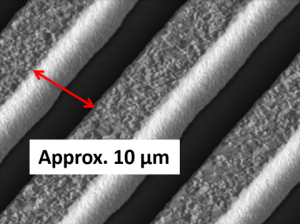Stanna-Flex®
New immersion tin finish for plating on flexible substrates with and without soldermask
Smooth
deposit
with homogeneous thickness
Low viscosity and mild process
to mitigate the risk of mouse bite defects
Compatible with our systems
such as Crystallizer® and ConStannic®

Stanna-Flex® is a new immersion tin finish which was developed for plating on flexible substrates with and without soldermask.Due to its low viscosity the bath provides excellent performance on fine line structures. With the improved solution exchange by lower viscosity and the Stannatech® 2000-proven 2-step plating process, the risk for mouse bite defect is mitigated.
The bath is capable to work with our Crystallizer® equip¬ment which allows a tight control range of the copper content in the plating bath and by that an increased bath life with no need for any feed and bleed processing.

- Mild immersion tin process for flex substrates that allows the plating of fine line structures with and without soldermask
- Cold tin predip prevents excessive copper dissolution at solder mask edges
- Low viscosity ensures excellent solution flow and easy rinsability of the substrate

- Smooth deposit using dedicated soft etch system for best performance
- Excellent solution flow and rinsability by low viscosity
- Substantial chemistry savings by use of our auxiliary equipment such as Crystallizer® and Constannic®
- Fine line capable to 10 µm L&S and below
What inspires us
Why we developed Stanna-Flex®
Your challenge
Flexible substrates no matter if with or without solder mask can be demanding for conventional immersion tin processes due to their fine and narrow structures. Due to the high viscosity of immersion tin electrolytes the solution flow is reduced and risk for excessive copper attack and mouse bite defects is increased.
Our solution
Stanna-Flex® is an immersion tin electrolyte specifically designed for flex substrates. Due to its reduced viscosity and the mild two step process the risk for mouse bite defects is strongly mitigated and the rinsablility is significantly improved. The process is fully compatible with our auxiliary equipment like the ConStannic® and Crystallizer which ensured substantial savings in chemistry consumption compared to other immersion tin processes in the market.

